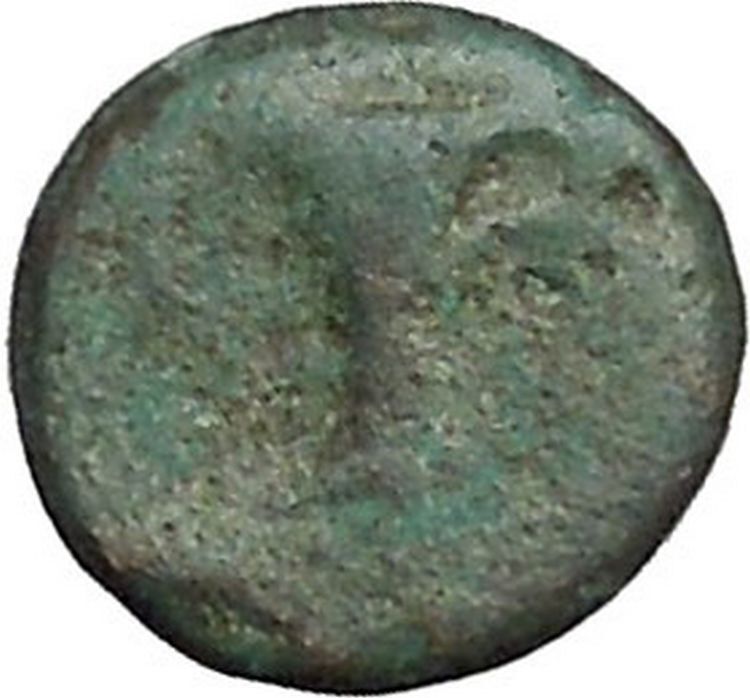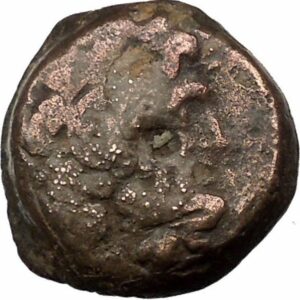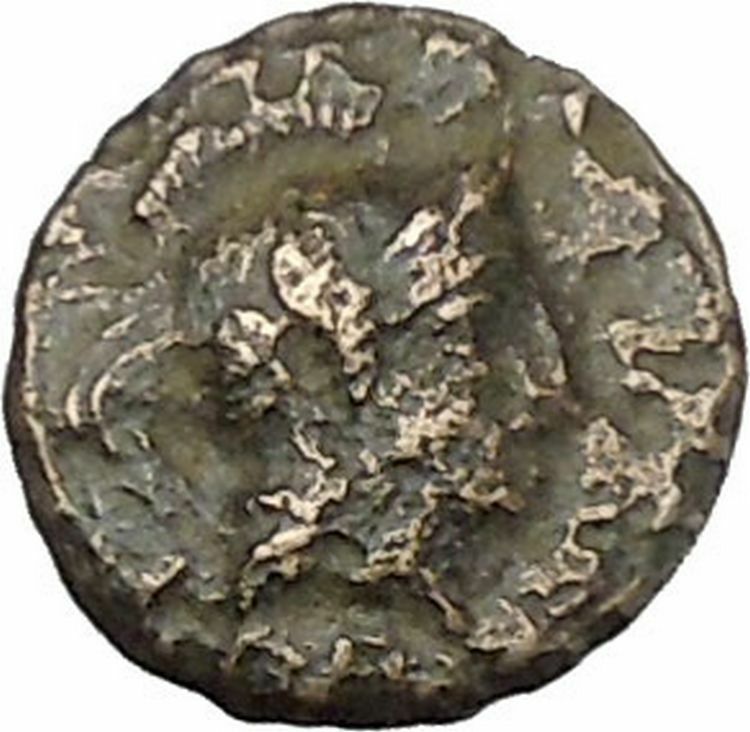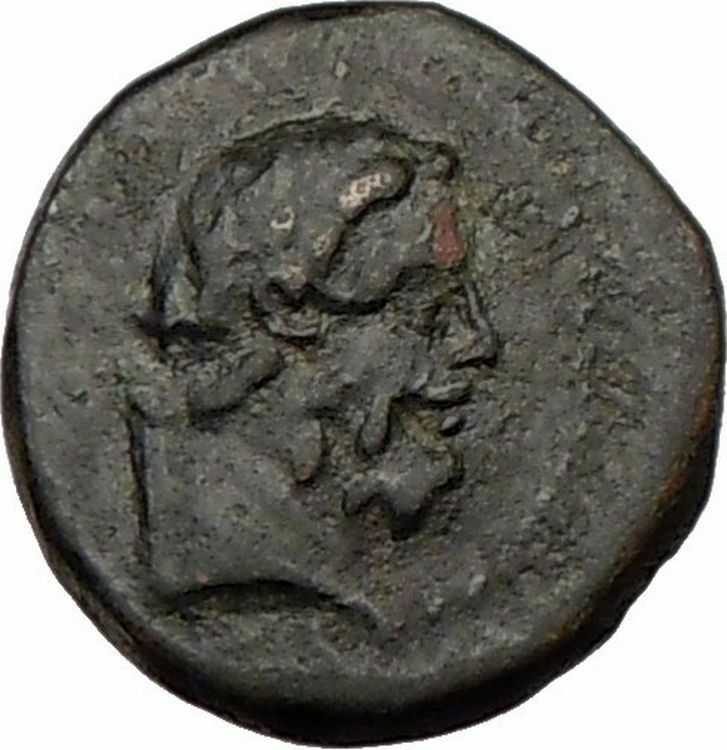|
Greek city of
Korykos in
Cilicia
Bronze 22mm (6.08 grams) Struck 1st Century B.C.
Reference: Sear 5545; B.M.C.21.66,1-4
Turreted head of Tyche right, AN behind.
Hermes standing left, holding phiale and caduceus;
ΚΩΡVKIΩΤΩΝ behind,
ΔΙ / NI / AN in field to left.
A coastal town midway between the
mouths of the rivers Lamos and Kalykadnos, Korykos was
chiefly known for the nearby mountain grotto, called the
Korykian Cave, which was celebrated by the poets.
You
are bidding on the exact item pictured, provided with a
Certificate of Authenticity and Lifetime Guarantee of
Authenticity.
Tyche (Greek for luck; the Roman equivalent was
Fortuna
) was the
presiding
tutelary deity
that
governed the fortune and prosperity of a city, its
destiny. Increasingly during the Hellenistic period,
cities had their own specific iconic version of Tyche,
wearing a
mural crown
(a crown
like the walls of the city).

The
Greek historian
Polybius
believed that
when no cause can be discovered to events such as
floods, droughts, frosts or even in politics, then the
cause of these events may be fairly attributed to Tyche.
Stylianos Spyridakis concisely expressed
Tyche’s appeal in a Hellenistic world of arbitrary
violence and unmeaning reverses: “In the turbulent years
of the
Epigoni of Alexander
,
an awareness of the instability of human affairs led
people to believe that Tyche, the blind mistress of
Fortune, governed mankind with an inconstancy which
explained the vicissitudes of the time.”
In literature, she might be given various
genealogies, as a daughter of
Hermes
and
Aphrodite
, or
considered as one of the
Oceanids
, daughters of
Oceanus
and
Tethys
, or of
Zeus
. She was connected
with
Nemesis
and
Agathos Daimon
(“good
spirit”).
She was uniquely venerated at
Itanos
in Crete, as
Tyche Protogeneia, linked with the Athenian
Protogeneia
(“firstborn”), daughter of
Erechtheus
, whose
self-sacrifice saved the city.
She had temples at
Caesarea Maritima
,
Antioch
,
Alexandria
and
Constantinople
. In
Alexandria
the
Tychaeon, the temple of Tyche, was described by
Libanius
as one of the
most magnificent of the entire Hellenistic world.
Tyche appears on many
coins
of the
Hellenistic period in the three centuries before the
Christian era, especially from cities in the Aegean.
Unpredictable turns of fortune drive the complicated
plotlines of
Hellenistic romances
,
such as
Leucippe and Clitophon
or
Daphnis and Chloe
.
She experienced a resurgence in another era of uneasy
change, the final days of publicly sanctioned
Paganism
, between the
late-fourth-century emperors
Julian
and
Theodosius I
who
definitively closed the temples. The effectiveness of
her capricious power even achieved respectability in
philosophical circles during that generation, though
among poets it was a commonplace to revile her for a
fickle harlot.
In
medieval art
, she was
depicted as carrying a
cornucopia
, an
emblematic
ship’s
rudder, and the
wheel of fortune
, or
she may stand on the wheel, presiding over the entire
circle of fate.
The constellation of
Virgo
is sometimes
identified as the heavenly figure of Tyche, as well as
other goddesses such as
Demeter
and
Astraea
.

Hermes
is the great messenger of the gods in
Greek mythology
and
additionally as a
guide to the Underworld
.
Hermes was born on
Mount Cyllene
in
Arcadia. An
Olympian god
, he is
also the patron of boundaries and of the travelers who
cross them, of
shepherds
and
cowherds
, of the
cunning of thieves and liars, of orators and wit, of
literature and poets, of athletics and sports, of
weights and measures, of invention, and of commerce in
general. His symbols include the tortoise, the rooster,
the winged sandals, the winged hat, and the
caduceus
(given to him
by Apollo in exchange for the lyre).
Symbols of Hermes were the palm tree, turtle, rooster,
goat, the number four, several kinds of fish, incense.
Sacrifices involved honey, cakes, pigs, goats, and
lambs.
In the Roman adaptation of the Greek religion (see
interpretatio romana
),
Hermes was identified with the Roman god
Mercury
, who, though
inherited from the
Etruscans
, developed
many similar characteristics, such as being the patron
of commerce.
The
Homeric hymn
to Hermes
invokes him as the one “of many shifts (polytropos),
blandly cunning, a robber, a cattle driver, a bringer of
dreams, a watcher by night, a thief at the gates, one
who was soon to show forth wonderful deeds among the
deathless gods.”
He protects and takes care of all the travelers,
miscreants, harlots, old
crones
and thieves that
pray to him or cross his path. He is athletic and is
always looking out for runners, or any athletes with
injuries who need his help.
Hermes is a messenger from the gods to humans,
sharing this role with
Iris
. An interpreter
who bridges the boundaries with strangers is a
hermeneus. Hermes gives us our word “hermeneutics“,
the study and theory of interpretation. In Greek a lucky
find was a hermaion. Hermes delivered messages
from Olympus to the mortal world. He wears shoes with
wings on them and uses them to fly freely between the
mortal and immortal world. Hermes was the second
youngest of the
Olympian gods
, being
born before
Dionysus
.
Hermes, as an inventor of fire, is a parallel of the
Titan
,
Prometheus
. In addition
to the
lyre
, Hermes was
believed to have invented many types of racing and the
sports of wrestling and boxing, and therefore was a
patron of athletes.
According to prominent
folklorist
Yeleazar Meletinsky
,
Hermes is a deified
trickster
. Hermes also
served as a
psychopomp
, or an
escort for the dead to help them find their way to the
afterlife
(the
Underworld
in the Greek
myths). In many Greek myths, Hermes was depicted as the
only god besides
Hades
,
Persephone
,
Hecate
, and
Thanatos
who could
enter and leave the Underworld without hindrance.
Hermes often helped travelers have a safe and easy
journey. Many Greeks would sacrifice to Hermes before
any trip.
In the fully-developed Olympian pantheon, Hermes was
the son of
Zeus
and the
Pleiade
Maia
, a daughter of the
Titan
Atlas
. Hermes’ symbols
were the
cock
and the
tortoise
, and he can be
recognized by his purse or pouch,
winged sandals
,
winged cap
, and the
herald’s staff, the
kerykeion
. The
night he was born he slipped away from Maia and stole
his elder brother
Apollo
Corycus (Greek:
Κώρυκος; also
transliterated
Corycos or Korykos;
Armenian
: Կոռիկոս)
was an ancient city in
Cilicia Trachaea
,
Anatolia
, located at the mouth of the Calycadnus
(now
Göksu
); the site is now occupied by the town of
Kızkalesi
(formerly Ghorgos),
Mersin Province
,
Turkey
.
The
city
Strabo
does not mention a town of Corycus, but
reports a promontory so called at the location, but a
town Corycus is mentioned by
Livy
(xxxiii. 20), and by
Pliny
(v. 27), and
Pomponius Mela
(i. 13), and
Stephanus of Byzantium
(s. v. Κώρυκος). In antiquity
Corycus was an important harbor and commercial town. It
was the port of
Seleucia
, where, in 191 BCE, the fleet of
Antiochus the Great
was defeated by the
Romans
. In the Roman times it preserved its ancient
laws; the emperors usually kept a fleet there to watch
over the pirates. Corycus was also a mint in antiquity
and some of its coins survive.
Corycus was controlled by the
Byzantine Empire
.
Justinian I
restored the public baths and a
hospital.
Alexios I Komnenos
re-equipped the fortress, which
had been dismantled. At the beginning of the 12th
century the Byzantines built a supplementary castle on a
small island. This castle was later called “maidens
castle” (Turkish:
Kız kalesi),
because it was told that a king held his daughter here
in captivity until she was killed by a venomous snake.
It was prophesied she would die by a snake bite. So she
was taken to the sea castle to protect her, but a
serpent was taken by basket to the castle, she was
bitten and died. Soon after Corycus was conquered by the
Armenians
, who held it till the middle of the 14th
century, as part of the
Armenian Kingdom of Cilicia
. In the 14th century,
the city was occupied temporarily by the
Turks
, and for a time played an important part. The
city fell to the
Lusignans
of
Cyprus
. It was taken by the
Mamelukes
, and again by
Peter I of Cyprus
in 1361. In the late 14th century
it fell again to the Turks. From 1448 or 1454 it
belonged alternately to the
Karamanlis
, the Egyptians, the Karamanlis a second
time, and finally to the
Osmanlis
.
The ruins of the city are extensive. Among them are a
triumphal arch, a
necropolis
with a beautiful
Christian
tomb,
sarcophagi
, etc. The two medieval castles, one on
the shore, the other in an islet, connected by a ruined
pier, are partially preserved; the former was reputed
impregnable. The walls of the castle on the mainland
contain many pieces of columns; and a mole of great
unhewn rocks projects from one angle of the fortress
about a hundred yards across the bay. Three churches are
also found, one decorated with frescoes. The walls of
the ancient city may still be traced, and there appear
to be sufficient remains to invite a careful examination
of the spot.
The city figures in the
Synecdemus
of
Hierocles
, and about 840 in
Gustav Parthey
‘s Notitia Prima.
Ecclesiastically, it was a
see
, suffragan of
Tarsus
.
Lequien
(II, 879) mentions five
Greek Orthodox
bishops from 381 to 680; another is
known from an inscription (Waddington, Inscriptions
… d’Asie mineure, 341). One
Latin
Bishop, Gerardus, was present at a
Council of Antioch
about 1136; four are known in the
fourteenth century (Lequien,
III, 1197;
Eubel
, I, 218). Corycus remains a
titular see
of the
Roman Catholic Church
, Coryciensis; the seat
is vacant since the death of the last bishop in 1967.
Corycian
Cave
Main article:
Arima, couch of Typhoeus
In the Corycian Cave (now Cennet ve Cehennem), 20
stadia inland, says Strabo, the best
crocus
(saffron)
grows. He describes this cave as a great hollow, of a
circular form, surrounded by a margin of rock, on all
sides of a considerable height; on descending into this
cavity, the ground is found to be uneven and generally
rocky, and it is filled with shrubs, both evergreen and
cultivated; in some parts the saffron is cultivated:
there is also a cave here which contains a large source,
which pours forth a river of pure, pellucid water, but
it immediately sinks into the earth, and flowing
underground enters the sea: they call it the Bitter
Water.
Pomponius Mela
(i.13) has a long description of the
same place apparently from the same authority that
Strabo followed, but more embellished. This place is
probably on the top of the mountain above Corycus.
This place is famed in
Greek mythology
. It is the
Cilician
cave of
Pindar
(Pythian Ode i. 31), and of
Aeschylus
(Prom. Vinct. 350), and as
Arima, couch of Typhoeus
, it is the lair of Zeus’
fiercest opponent, the giant
Typhon
or Typhoeus.
|











